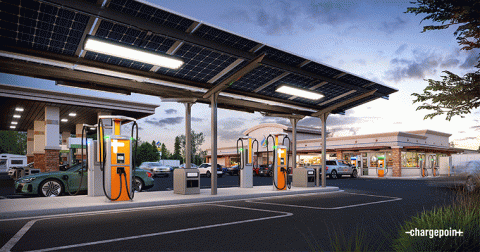Five Questions to Consider Before Creating an EV Charging Program

A decade from now, transportation as we know it will be barely recognizable — and the opportunity for businesses to benefit is clear. We’re at the beginning of the biggest change in transportation since Henry Ford debuted the Model T, and it’s happening before our eyes.
The Biden administration just proposed the strongest-ever federal pollution standards for cars and trucks, meaning by 2032, 67% of all new passenger cars sold in the US will be electric. Tax credits are available for those purchasing an electric vehicle (EV), while public funds can help offset the cost of installing EV charging infrastructure for businesses. Now is the time for businesses to get involved in the shift to electric mobility.
Because EV chargers can be installed anywhere there is electric supply available, EV owners can plug their car in to charge and do something else while they wait — grocery shop, grab a bite to eat or even get a haircut. This means every organization can be part of the new fueling network by making an investment in EV charging — and we’re seeing it happen already. ChargePoint partnered with Starbucks and Volvo to roll out fast charging at coffee shops throughout the Northwest, while Walmart has announced plans to build its own EV fast-charging network at thousands of locations across the country. One major retailer that ChargePoint worked with found that adding EV charging tripled customers’ time in its store and increased customer spend proportionately.
For businesses ready to participate in the electric revolution, here are five important questions to get the right infrastructure in place to move forward with EV charging.
- How much electrical supply will you need? One of the first steps in EV charging implementation is ensuring sufficient electrical supply at the site. High-speed, DC fast charging typically requires 480 volt, 3-phase electrical service. Even if you don’t plan to install many chargers right now, invest in sufficient electrical service and underground infrastructure now to avoid having to dig up the parking lot again to add capacity in the future.
- How much space do you have available for infrastructure? Along with evaluating your electrical needs, consider the amount of space you have available at your location and how it relates to other infrastructure onsite. As you scale to serve and provide fuel for EV drivers, think about where you will put new electrical panels, power cabinets, conduit runs and charging stations themselves to fit with your available space and create a convenient experience for your EV-driving guests.
- What are the accessibility laws in your area? How will you account for the path of travel? Research the accessibility requirements for the jurisdiction where you are installing chargers. In some cases, you’ll need to ensure appropriate access to the aisles as well as clear in-store pathways from at least one charging station.
- What will be your next phase of fast-charging site development? As you consider what charging will look like today, I encourage future-proofing infrastructure upfront. Add sufficient electrical capacity to expand over time and put in a flexible solution that can scale to meet demand as more drivers choose electric.
Modular solutions (which can add power or stations as needed) help you scale up charging availability. In most cases, it’s best to do as much as you can to prepare your location today, so you will be ready for tomorrow.
- How will you pay for the charging infrastructure? Fortunately, lots of funds are available from federal, state and local agencies, as well as utility companies in regions throughout North America. For example, the National Electric Vehicle Infrastructure (NEVI) formula program allocated $5 billion to help pay for DC fast charging infrastructure within one mile of interstate highways. And more than $70 million in grants and incentives are also available at the state level.
Convenience stores, retail locations, grocery stores and other types of organizations can benefit from the next transportation transformation. Will your business be a part of the next big thing?





